There are more than 500 species of shark and they live in all of the seas around the world, and even in some rivers. Sharks are able and effective hunters but have a notorious reputation and many are greatly feared. However, although it might seem like sharks are abundant, there are many species which are under great threat and are on the brink of extinction. Here we’ll discover the most endangered sharks in the world! While these sharks are in no particular order, keep in mind many are very threatened. One shark in this list is so rare it was considered extinct for many years!
10. Ganges Shark
One of the rarest sharks in the world is the Ganges shark which is a critically endangered requiem shark. Ganges sharks are true river sharks, which means that they have adapted to survive in a freshwater environment, and are found in rivers in India and Bangladesh – particularly the Ganges, Brahmaputra, and Hooghly rivers. Ganges sharks are brownish-grey and have stocky bodies, with a broad snout and small eyes. They are around 2 feet long at birth and mature to between 5 and 6.5 feet long. Ganges sharks feed by swimming along the bottom of the rivers while scanning the water above for their prey. Their teeth are designed for puncturing fish rather than mammals and they eat mainly freshwater rays and bony fish.
Ganges sharks are widely feared but are often mistaken for the much more vicious bull shark, which can also inhabit rivers. Many of the attacks blamed on Ganges sharks have actually been carried out by bull sharks and scientists believe that as Ganges sharks are so rare they rarely come into contact with humans. It is thought that there are only around 250 Ganges sharks left in the world today. Their main threats for these endangered sharks are human-related – habitat pollution, increased river use, construction of dams, and hunting.
9. Daggernose Shark
Daggernose sharks are found in shallow tropical waters along the northeast coast of South America where their preferred depths are between 10 and 130 feet. They are not particularly large sharks and only reach lengths of around 5 feet. Daggernose sharks are distinctive as their snouts are long and flat and have a very pointed tip. They eat mainly small fish, such as anchovies, catfish, and herring. Daggernose sharks mate at the end of the rainy season and gestation lasts for one year. However, they can alter the timing of their reproductive cycle by up to four months, depending on habitat conditions. Daggernose sharks are critically endangered and are considered to be on the brink of extinction. Daggernose sharks are regularly hunted for food and caught as bycatch. These are the main reasons for the decline in their population.
8. Oceanic Whitetip

Oceanic whitetips are believed to have killed more people than great white sharks
©iStock.com/NaluPhoto
One of the most notorious endangered sharks is the oceanic whitetip. Oceanic whitetips have white tips on their fins and reach 13 feet long. They are best known for being especially dangerous to the survivors of plane and shipwrecks and some reports claim they’ve killed more people than even great white sharks and bull sharks (although official records point to the great white holding the title of the world’s most dangerous shark). Oceanic whitetips are solitary sharks and live in open tropical oceans around the world. Although they were once extremely common around the world, their numbers have declined rapidly and they are now critically endangered sharks. Oceanic whitetips suffer a lot of pressure from the fishing industry worldwide as their fins are the main ingredient in shark fin soup.
7. Pondicherry Shark
Pondicherry sharks are extremely rare requiem sharks. They have a stocky build and are no longer than 3 ft 3 in. They are distinctive and have noticeable black tips on their pectoral fins, second dorsal fin, and lower caudal fin. Pondicherry sharks were once widespread across the Indo-Pacific and were caught regularly off the coasts of India and Pakistan. However, Pondicherry sharks were thought to be extinct between the 1970s and 2011 when they were rediscovered in India. Officially, Pondicherry sharks are officially critically endangered, but they are seen so rarely it might not be long before they are thought to be extinct again.
6. Sand Tiger Shark
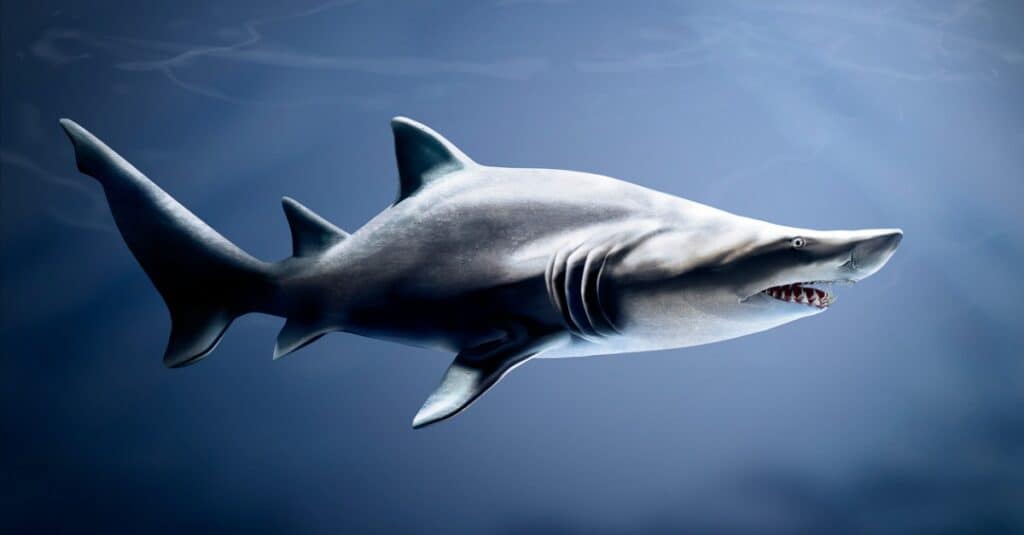
These sharks have the lowest reproduction rate of all sharks
©iStock.com/mirror-images
Sand tiger sharks have a few different names, depending on where they are found, and are also known as sand sharks, grey nurse sharks (Australia), and ragged-tooth sharks (Africa). They live in tropical and subtropical waters worldwide and get their “sand” name from their preference for shallow, sandy coastlines. They have thick bodies and pointed heads and reach around 10 feet long. Sand tiger sharks in Australia and South Africa migrate more than 1,000 miles every year. They give birth in colder water and then travel north to areas with rock and caves to mate again during the winter. They then migrate even further north to warmer water for the duration of their gestation before traveling south again to give birth.
Sand tiger sharks have the lowest reproduction rate of all sharks and only have 1 or 2 pups every two to three years. This is the main reason that sand tiger sharks are critically endangered. However, the implementation of shark nets around beaches has also contributed to their decline.
5. Great Hammerhead Shark
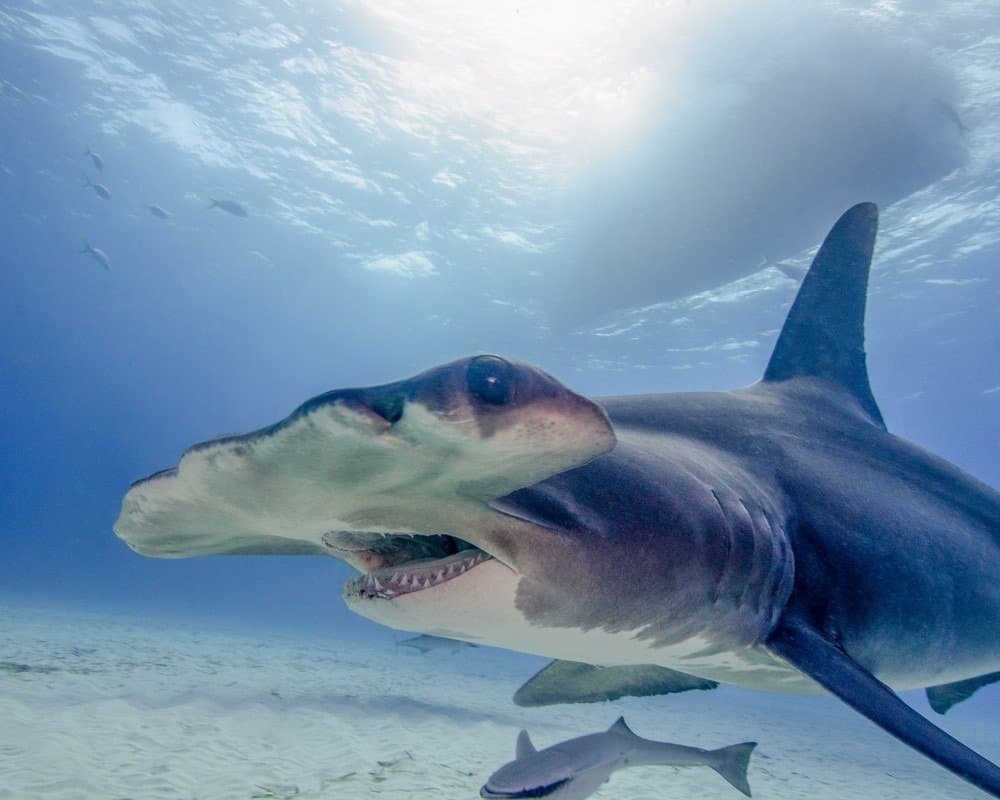
Great Hammerhead Shark in the Bahamas
©Brent Barnes/Shutterstock.com
As the largest hammerhead shark, great hammerheads easily reach 15 to 20 feet. They are one of the most unique and distinctive sharks in the world with their hammer-shaped snouts. Great hammerhead sharks live in tropical water around the world. Some populations from Florida and the South China Sea migrate closer to the poles in the summer months. They are solitary sharks and feed on a wide range of prey, including bony fish, crabs, octopuses, and smaller sharks. The only natural predator of great hammerheads is killer whales. However, humans are a major threat to them through overfishing and bycatch. Sadly, great hammerheads are now critically endangered sharks and in many regions their population has declined by up to 80% in the last 25 years.
4. Whale Shark
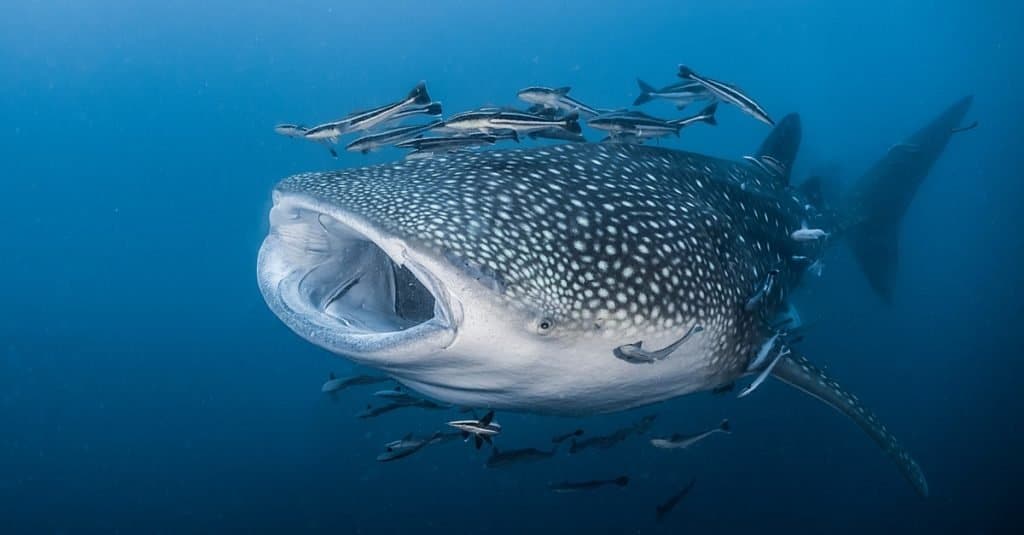
©Onusa Putapitak/Shutterstock.com
Whale sharks are the largest shark in the world and the largest known fish, reaching around 60 feet. They live in tropical seas all around the world, both offshore and in coastal areas. Whale sharks have dark grey skin and white bellies with a range of spots and stripes which are individual to each shark. They are called whale sharks because of their large size, and because they are filter feeders like baleen whales. Whale sharks have more than 300 rows of small teeth and 20 filter pads. They use the filter pads to strain food through – generally plankton – which catches on the filters while the water is forced back out through their gills.
Unfortunately, whale sharks are officially endangered and there are no reliable estimations of their numbers available. Their main threats come from vessel strikes, overfishing, bycatch, and the fact that they are slow to mature and reproduce. In addition, it is believed that the oil spill in the Gulf of Mexico in 2010 played a part in their decline as it occurred in the area where many of them used to feed.
3. Dusky Shark
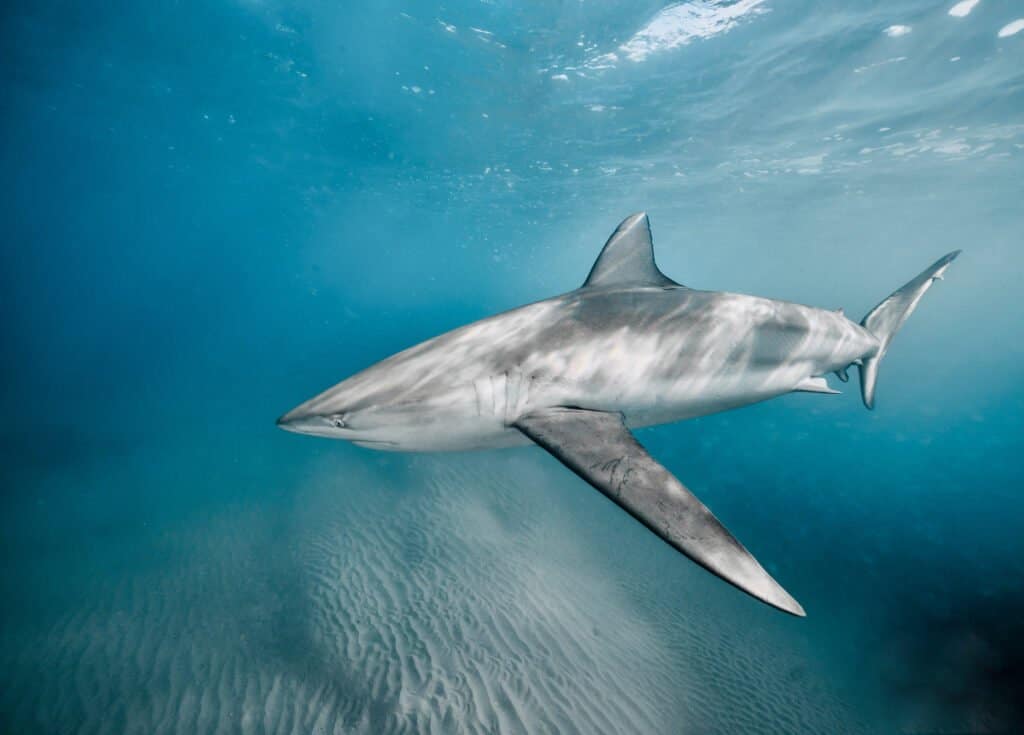
A dusky shark swims in the Mediterranean Sea
©sirtravelalot/Shutterstock.com
Another officially endangered shark is the dusky shark which occurs worldwide in tropical and subtropical waters. Dusky sharks can reach 14 feet in length and are grey or beige with a streamlined body and five pairs of gills. They generally hunt near the bottom of the ocean and have a varied diet. Dusky sharks have a particularly long gestation of almost two years. There is also one year gap between pregnancies, meaning they are slow to reproduce. Dusky sharks are highly sought after for the shark fin trade and are also regularly caught by sport fishermen. In the past, many dusky sharks were caught in shark nets off the coasts of Australia and South Africa. This is believed to have significantly contributed to the collapse of their population.
2. Great White Shark
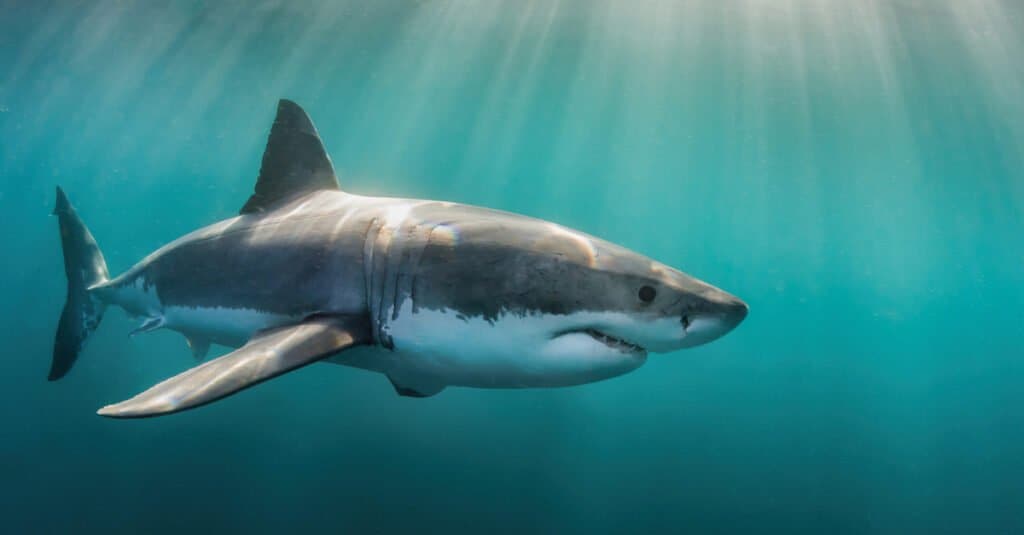
The great white shark has 300 teeth set in seven rows.
©Fiona Ayerst/Shutterstock.com
Easily the best known of all sharks is the great white shark. Great white sharks have been made famous by films and documentaries depicting them as ruthless killers, but actually, they have plenty to fear from us! Great white sharks are officially a vulnerable species. Their population has declined significantly in recent years and it is estimated that there are fewer than 3,500 remaining. The main cause of this is thought to be because of sport fishing and incidents where they are caught in the shark netting surrounding beaches. Great whites are also subject to Australia’s shark control program (shark culling). Great white sharks live in water between 12 and 24 °C in both coastal and offshore areas.
1. Common Thresher Shark
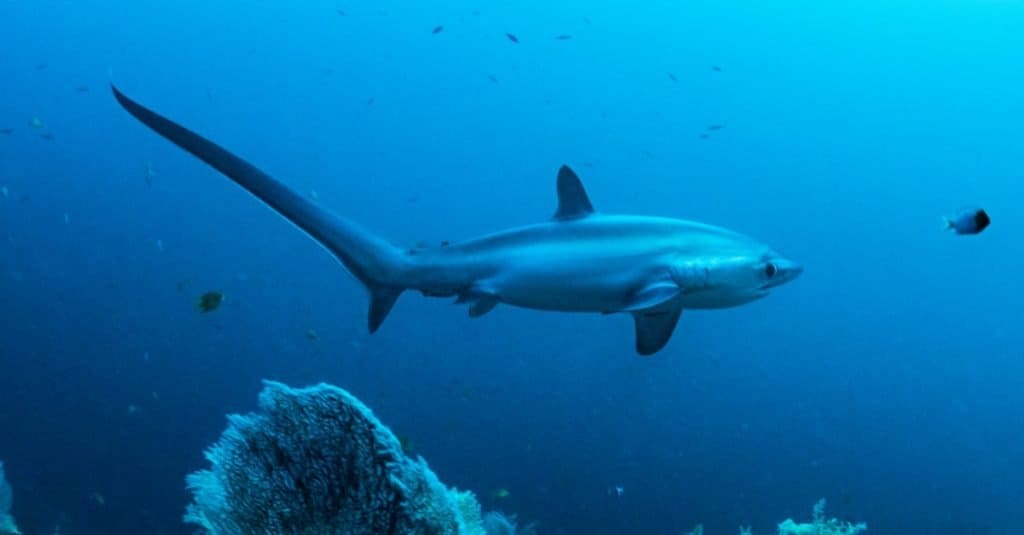
The most notable feature of the
thresher shark
is the long, whip-like upper lobe of their tail, which is known as the caudal fin.
©Shane Gross/Shutterstock.com
Also known as Atlantic threshers, common thresher sharks are easily distinguished by their extra long upper tail fin. They can reach 20 feet and their tail makes up around half of their length. Common threshers are migratory and live in many seas around the world. They regularly move to higher latitude areas to head into warmer water. Common thresher sharks are strong, fast swimmers and eat mainly bony fish. They use their long tail to strike and incapacitate their prey. Common threshers are caught by commercial fishers as they are highly sought after for their meat. They are also a valued prize by sport fishers due to their power and the fight that they put up. Common thresher sharks are a vulnerable species due to fishing pressure on populations.
Up Next
The photo featured at the top of this post is © iStock.com/mirror-images
Thank you for reading! Have some feedback for us? Contact the AZ Animals editorial team.






